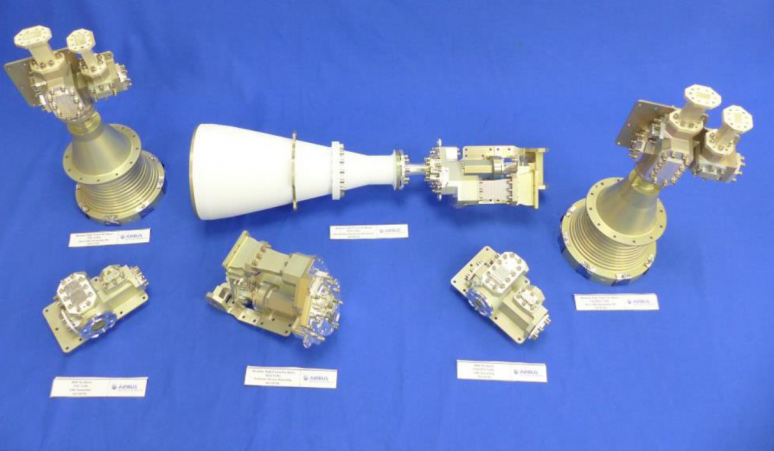
-
StatusCompleted
-
Status date2017-05-29
-
Activity Code5C.209
FSS and BSS services in Ku-band are expected to remain the strongest branch in the satellite telecommunications market.
Objective of the project was the development of successors for the existing Ku band OMTs, which were used successfully over a decade. The requests for additional band width, higher power handling and the avoidance of resonances caused of higher order modes necessitated a family of new products, since all requirements cannot be covered with a single feed chain.
Airbus decided to meet the demands of the market with three feed chains tailored for:
- FSS Tx/Rx, 10.7 - 14.8 GHz, dual linear polarisation
- Extended FSS/BSS Tx/Rx 10.7 - 14.8 & 17.2 - 18.4 GHz, dual linear polarisation
- Extended BSS Tx/Rx 10.7 - 12.75 & 17.2 - 18.4 GHz, dual circular polarisation
The corresponding polariser devices were designed, manufactured and assembled. Typical axial corrugated horns were used to demonstrate the performance of the feed chains. Figure 1 shows the EQM feed chains with assembled horn and also the stand alone polarising devices (PDs).

All feed chains passed the environmental testing comprising thermal cycling and vibration test successfully. The RF testing showed good accordance to the predictions and revealed excellent performance of all three products.
The major challenges for the devices to be developed were:
- High power handling considering
- Multipaction threshold
- Losses and dissipation power
- PIM performance
- Thermal concept
- Avoidance of resonances caused of higher order modes
With the three newly developed polariser devices, Airbus is able to deliver a suitable Ku band feed product for practically all high power satellite telecommunication antennas. The polariser devices or entire feed chains can be offered to the internal as well as to external customers. The new products are supposed to replace the very successful Ku-band OMTs which were applied in the last decade but are not able to fulfil the power demands of future satellite missions. The specifications of the new products were defined not only to satisfy current requests, but to cover also future demands. For example the FSS Tx/Rx polariser device is able to handle 4kW per polarisation. This is the basis for a long-lasting life time cycle of the products.
All polariser devices show a return loss better 21 dB. For the linear devices, the isolation between horizontal and vertical polarisation is better 45 dB, for the circular one a port to port isolation better 19dB could be achieved.
Beside the good performance w.r.t. the S-parameter, all polariser devices were optimised for power handling, which means a high multipaction threshold and low losses.
The worst case losses for the FSS Tx/Rx polariser device is 0.06 dB, for the FSS/BSS Tx/Rx 0.1 dB and for the circular one 0.09 dB for Tx and 0.25 dB for Rx. The average losses, which are important for the thermal layout in practice, are even noticeable below.
The devices passed successfully the multipaction test with 6000 W at the input ports (maximum available input power of the test bed). Likewise, all three feed chains where thermally PIM tested, 3rd order for the linear ones and 6th/7th order for the circular. They all showed a performance below the noise floor and therewith easily fulfilling the requirement of -130 dBm.
From mechanical point of view, the three feed chains were qualified to be applicable in all kind of antennas used on a spacecraft, i.e.
• Dual reflector antenna
• Single offset reflector antenna
• Global horn antenna.
The entire project was divided in two phases.
In the first phase, a comprehensive study was performed to collect current and future market requirements for Ku band feed chains on telecommunication satellites. Simultaneously, a literature study was carried out to find suitable possible solutions. At the end of the study phase requirements for three devices covering the different requests were defined and the most promising design solutions identified.
In the second phase, the RF designs were finalized and fitted to the mechanical and thermal design of the polariser devices. The PDs where manufactured and qualified to flight standard.
Project is finished successfully.
The first units out of the developed products are already manufactured for flight application.


